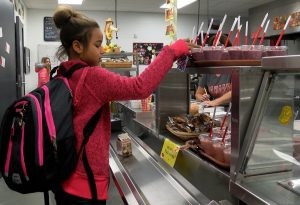Dairy is a nutritional powerhouse. With 13 essential nutrients, more hydrating than water and packed with protein, milk plays a critical role in youth nutrition. Dairy checkoffs are hard at work to ensure the science is being shared with decision makers in school systems. Their work ensures that dairy is in schools making a positive impact on students’ lives – both during the school year and over summer months.
“We know dairy foods deliver a unique package of 13 essential nutrients that help not only with building strong bones and muscle, but also support a healthy immune system and provide energy to grow and learn,” Hanna Kelley, RD, LD, Director of Health and Wellness at American Dairy Association Indiana Inc. (ADAI) said. “Milk, cheese, and yogurt contain high quality protein to keep students fuller longer, and is particularly helpful when students have to wait longer for their next meal due to after school jobs, events and activities.”
While milk is federally required to be offered during school meals because of the critical role it plays in youth nutrition, dairy checkoffs recognize the value of finding creative ways to make students’ experience with dairy products even more enjoyable.
 “In our schools, 80% of school meals include a milk. Schools must offer milk with every meal, but students are not required to take one,” Scott Higgins, President & CEO of American Dairy Association (ADA) Mideast said. “We work with schools to include multiple dairy products on their daily menu. This helps ensure that the child who doesn’t choose milk can choose yogurt or a yogurt-based smoothie. It’s about increasing student access for additional dairy products.”
“In our schools, 80% of school meals include a milk. Schools must offer milk with every meal, but students are not required to take one,” Scott Higgins, President & CEO of American Dairy Association (ADA) Mideast said. “We work with schools to include multiple dairy products on their daily menu. This helps ensure that the child who doesn’t choose milk can choose yogurt or a yogurt-based smoothie. It’s about increasing student access for additional dairy products.”
The focus on expanding dairy offerings in schools is consistent for all checkoffs in the Great Lakes region. Each program, although slightly different, involves checkoff staff partnering with school administrators and lunch coordinators to provide equipment, recipes and resources to diversify the types of dairy products offered.
“We have a program called Moolah for Schools where schools can apply for a grant that provides equipment and resources for programming around smoothies, hot chocolate, milk and lattes,” Cortney Freeland, MPH, CHES, Vice President of Strategic Partnerships at United Dairy Industry of Michigan (UDIM) said. “As part of all of those different categories, we’re working to support schools in ensuring that kids have the best experience with mealtime and specifically dairy.”
Providing unique dairy offerings allows students to receive the benefits of dairy in a fun, exciting format. The most popular Moolah for Schools grant program right now is for lattes at the high school level.
“Students are going to Starbucks or a local convenience store and bringing lattes into school, so why not translate that into additional revenue for the school and additional nutrition for the students?” Cortney said. “Our latte program brings high schoolers into the cafeteria to get what they were already going to go get, only this time we can ensure that it has a full serving of dairy.”
Similarly, in Ohio, ADA Mideast has had success with their smoothie program.
“We did a post analysis of the 94 schools we brought smoothie equipment into this year and found that we sold five tons of yogurt,” Higgins said. “That’s five tons of additional yogurt each month that otherwise would never have been made available in schools and it was only because we went in and said, ‘Hey, have you ever thought about yogurt in smoothies?’”
The creativity in dairy offerings mutually benefits dairy farmers and students by growing dairy sales now and creating future dairy buyers, while also ensuring students receive the benefits of dairy and school administrators seeing the positive effects.
“After enrolling in one of our dairy programs, school administrators see test scores improve, attendance go up and the number of illnesses go down,” Higgin said. “Once we’ve proven the difference dairy can make and shown it to a school district, it’s amazing how many schools want to be like that school district and do it the same way.”
These benefits go on to further encourage neighboring school districts to get involved with the dairy checkoff, expanding the checkoff’s influence in schools. With students’ attention captive in classrooms and lunchrooms for nine months out of the year, checkoffs recognize how important that opportunity to market dairy is.
 “If school is the moment that we have an opportunity to give students our best product, we should be doing everything we can to offer them opportunities to enjoy milk, cheese, yogurt, smoothies and hot chocolate,” Higgins said.
“If school is the moment that we have an opportunity to give students our best product, we should be doing everything we can to offer them opportunities to enjoy milk, cheese, yogurt, smoothies and hot chocolate,” Higgins said.
Schools are also the perfect setting to make a difference in student lives because of the dairy industry and school administrator’s aligned goals.
“Everyone is working so hard to feed our kids and our food service directors really understand the value of dairy as part of school meals,” Freeland said. “The pandemic solidified the need for our support and work that we do in schools, and that our efforts are truly a partnership with the schools. We’re all working towards the same thing, which is feeding our kids and ensuring they have the nutrition that they need.”
The goal of meeting students’ nutritional needs doesn’t end during the school year. Checkoffs’ partnerships with schools and state level organizations extend over the summer months, ensuring that dairy continues to fill what is often a critical gap in student nutrition.
“Many schools provide both breakfast and lunch opportunities for students to help meet their nutritional needs during the school year,” Kelley said. “Without them, kids living in food-insecure homes, may have little to nothing on the table. Summer meals programs fill in the gaps, making sure that every child is getting the nutrition they need to grow up as healthy, happy, productive people.”
By providing nutrition education and resources in school settings, dairy checkoffs are not only improving dairy sales, but making a positive difference in the lives of students both now and in the future.
This article was originally published in the July/August 2023 issue of the Milk Messenger. Subscribe »

